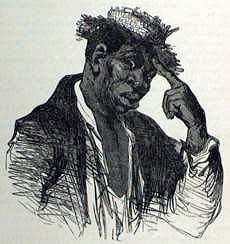The first truly American theatrical form was the minstrel show. In 1828, Thomas "Daddy" Rice, performed "Jump Jim Crow" in blackface Louisville, Kentucky to great acclaim, and from there the minstrel show evolved into an intricately structured three-act variety show replete with stock characters and jokes, as well as singing, dancing and skits. Minstrel shows were performed exclusively by white men originally, and drew from stereotypes of lazy slaves, sly tricksters and docile, infantilized men. These caricatures were popular both throughout the north and the south, and black minstrel troupes started to tour after the Civil War, taking up the stereotypes created and perpetrated by white performers.
"The minstrel show’s message was that black people belonged only on Southern plantations and had no place at all in the North. “Dis being free,” complained one minstrel character who had run away from the plantation, “is worser dem being a slave.” Songs like Dan Emmett’s “Dixie,” a Northern minstrel song which was introduced in New York City in 1859 by Bryant’s Minstrels, underscored these messages by having Northern blacks wish they were in the land of cotton" ("Minstrel Men and Minstrel Myths, Robert C. Toll).

By the turn of the century, minstrel shows had lost much of their traction as vaudeville and musical theatre gained popularity. But Al Jolson can still be seen in blackface in the first talky, The Jazz Singer, and minstrel and blackface performances continued to be seen on television as part of variety acts through the 1950s.
It is easy to say that minstrel shows are an ignominious but closed chapter of American entertainment, but Cornelius Eady's poetry confronts the contemporary ramifications of this form in Brutal Imagination. By dramatizing all the composite caricatures that Susan--and the American people, as the nine-day manhunt intensified--impose on this cipher of a black man, he makes it impossible to ignore continued presence of racial profiling and stereotyping in America in the present day. Dramaturgically, Eady pauses Susan's narrative as Mr. Zero forces her to confront her own sublimated prejudices. She doesn't believe her lie is racially motivated (her statement "I knew I'd get further with it if I said a black man did it" is merely factual, not racist in her mind) until she is compelled to watch these stereotypes deployed.
As we got deeper into the rehearsal process it became clear that the only way to approach the presence of these stereotypes in the script was to tackle them head on. Watching youtube videos of blackface performers and minstrel skits in rehearsal was itself a profoundly uncomfortable experience. We looked particularly at the physical attributes of Uncle Tom, Aunt Jemima, Buckwheat, Steppinfetchit and Stagolee. Minstrelsy manifests itself in our production in the dehumanized dance each caricature performs for Susan.
In these performances it becomes impossible to ignore or neatly dismiss not only her complicity but her active contribution to perpetrating these stereotypes by falsely accusing a black man of committing her crime. Hopefully this postmodern minstrel narrative allows the audience to call into question its own assumptions about race and representation as Susan's story continues to unfold.


No comments:
Post a Comment